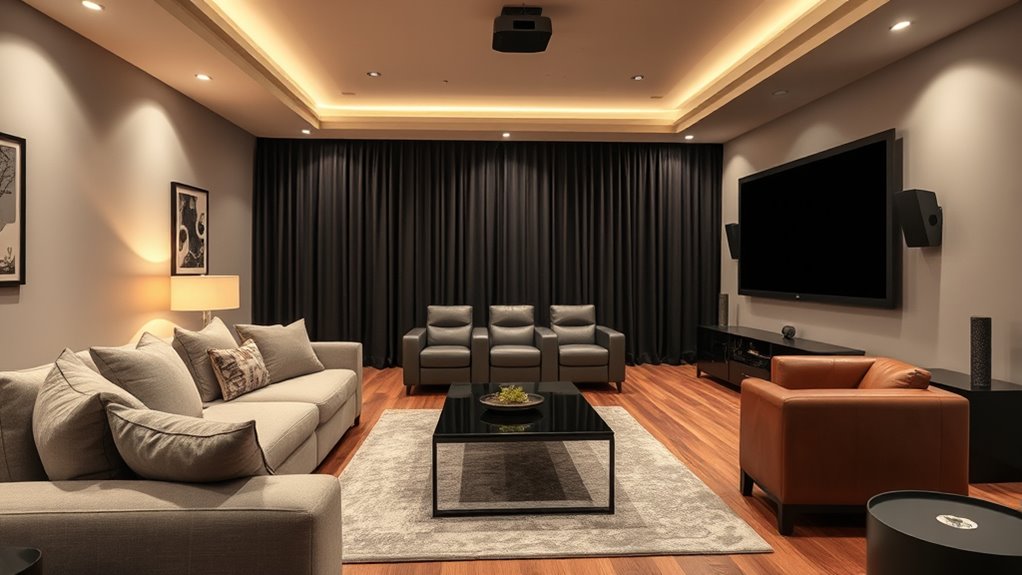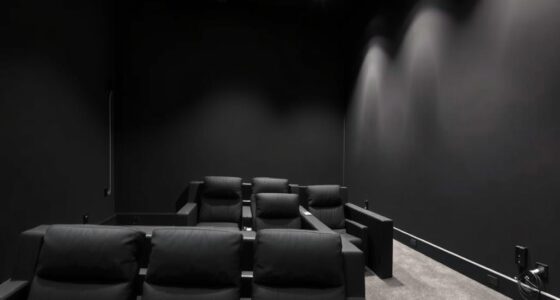Choosing between a living room and a dedicated theater depends on your space, budget, and priorities. Many believe you need giant screens and perfect lighting, but small adjustments can greatly improve your experience. While a dedicated theater offers superior audio and picture quality, a living room provides flexibility and practicality. If you want to learn how to optimize each setup for your needs, keep exploring what truly makes a difference.
Key Takeaways
- Screen size should match room size and viewing distance, not necessarily be large to ensure quality.
- Ambient lighting adjustments, like blackout curtains and dimmable lights, significantly improve picture quality in both setups.
- Dedicated theaters often provide superior audio and picture quality but require larger space and higher budget.
- Living rooms offer versatility for multiple activities but may limit high-end audiovisual performance.
- Choice depends on lifestyle, space, and budget; dedicated theaters prioritize immersion, while living rooms focus on flexibility.
Debunking Common Misconceptions About Home Theaters

Many people assume that setting up a home theater requires a massive budget or a dedicated room the size of a cinema. While larger screens can enhance your viewing experience, you don’t need a giant screen to enjoy quality entertainment. The key is choosing the right screen size for your space and viewing distance. Additionally, ambient lighting isn’t a problem if you control it effectively. Bright lights or sunlight can wash out the picture, but simple solutions like blackout curtains or dimmable lights help create the perfect viewing environment. You don’t need a dark, windowless room to get great picture quality. Small adjustments to your ambient lighting and screen size can make a significant difference, debunking the myth that only high-end, dedicated theaters deliver an immersive experience. Proper projector placement and understanding contrast ratios can further improve your home cinema setup.
The Cost and Space Considerations for Both Options

When considering whether to set up a living room entertainment area or a dedicated home theater, budget constraints and space optimization are essential. A living room setup typically costs less because it uses existing furniture and requires minimal upgrades, making it ideal if you have limited funds. In contrast, a dedicated theater demands a larger initial investment for specialized equipment, soundproofing, and room modifications. Space-wise, a living room is already available but may limit your options for high-end equipment. A dedicated theater, however, needs sufficient room for screens, seating, and acoustics, which can be a challenge if space is tight. Balancing your budget and available space helps you choose the option that offers the best experience without overspending or sacrificing comfort. Additionally, understanding home entertainment trends can help inform your decision to ensure your setup remains current and enjoyable.
Audio and Visual Quality: Which Setup Delivers Better Experience?

A dedicated home theater often provides a superior audio and visual experience compared to a living room setup. With surround sound systems, you get immersive audio that places you right in the middle of the action, enhancing every scene and soundtrack. Picture quality also tends to be sharper, thanks to high-end projectors and calibrated displays designed specifically for cinematic viewing. In a dedicated space, you can optimize acoustics and lighting, minimizing distractions and maximizing clarity. Additionally, selecting high‑end home appliances tailored for entertainment can further elevate your viewing experience. While living rooms can support decent audio-visual setups, they often lack the dedicated infrastructure needed for true excellence. Ultimately, if you prioritize immersive sound and stunning picture quality, a dedicated theater setup clearly offers the better experience.
Flexibility and Functionality in Living Rooms Versus Dedicated Spaces

While dedicated home theaters excel in delivering ideal audio-visual experiences, their primary limitation lies in flexibility. They are usually designed for a single purpose, making it hard to adapt the space for other activities. In contrast, living rooms are multi-purpose spaces, offering greater functionality for everyday life. You can easily switch between relaxing, hosting guests, or even working, thanks to furniture flexibility. Modular sofas, foldable tables, and versatile storage solutions make your living room adaptable to changing needs. This flexibility allows you to maximize space use without sacrificing comfort or utility. Additionally, understanding perfecting Earl Grey Tea and other tea preparation techniques can enhance your relaxation routines, making your living space even more inviting. If you value a room that can serve multiple functions and adjust to your lifestyle, a living room provides the versatility that dedicated spaces often lack.
Making the Right Choice Based on Personal Preferences and Lifestyle

Choosing between a living room and a dedicated theater depends largely on your personal preferences and lifestyle. If you value versatility, a living room’s flexible room layout allows for casual gatherings and daily activities. On the other hand, a dedicated theater offers a focused environment optimized for immersive viewing experiences. Your decor choices also matter—whether you prefer a cozy, multi-purpose space or a sleek, cinema-inspired setup. Consider how often you entertain guests, the importance of multi-functionality, and your aesthetic taste. Think about the room’s size, lighting options, and furniture arrangement. Additionally, understanding the lighting conditions can significantly enhance your viewing experience in either space. Ultimately, your decision should align with how you envision using the space regularly, balancing comfort, practicality, and style to suit your unique lifestyle.
Frequently Asked Questions
How Does Lighting Impact the Viewing Experience in Different Setups?
Lighting greatly affects your viewing experience by controlling ambient lighting and natural glare. In a dedicated theater, dim or adjustable lighting reduces glare and enhances picture quality, making movies more immersive. In a living room, managing ambient lighting with curtains or dimmers prevents natural glare that can wash out the display. Proper lighting setup guarantees you enjoy clear visuals and avoids eye strain, regardless of your setup.
Can a Living Room Be Upgraded to Match a Dedicated Theater’s Quality?
Yes, you can transform your living room into a cinematic haven. Start by rearranging furniture to mimic theater seating, creating a cozy, immersive space. Add decor enhancements like blackout curtains, soundproofing, and dimmable lighting to set the mood. These tweaks turn your everyday room into a personal theater, making every movie night feel like stepping into a blockbuster. With a little effort, your living space can rival a dedicated theater’s magic.
What Are the Long-Term Maintenance Costs for Each Setup Type?
You’ll find that maintenance costs for a living room setup are generally lower, thanks to simpler equipment and fewer upgrades needed over time. A dedicated theater incurs higher costs, especially with specialized components and regular upgrades like soundproofing and advanced AV gear. A thorough cost comparison shows that initial investments are higher for a dedicated theater, but ongoing maintenance and upgrade options can be more manageable in a living room environment.
How Does Room Acoustics Influence Sound Quality in Both Options?
Room acoustics greatly influence sound quality in both options. You can improve acoustics by adding sound absorption materials like rugs, curtains, and acoustic panels, which help reduce echo and unwanted reverberations. Properly managing echo reduction guarantees clearer dialogue and richer sound. Whether in a living room or dedicated theater, optimizing room acoustics creates a more immersive experience, making your audio feel more natural and enjoyable.
Are There Hybrid Solutions That Combine Benefits of Both Setups?
Yes, you can find hybrid solutions that combine the benefits of both setups. Look for multi-purpose rooms with modular solutions, allowing you to easily switch between a cozy living room and a dedicated theater experience. These adaptable spaces give you the flexibility to optimize acoustics, seating, and screen placement based on your needs. With smart design choices, you get a versatile environment that delivers great sound and visuals in any configuration.
Conclusion
Ultimately, choosing between a living room or dedicated theater is like picking the right tool for a job—you’ll succeed when it fits your needs. I once transformed my cluttered living room into a cozy movie nook, proving that a thoughtful setup beats expensive gear. Remember, it’s not about the size or cost but creating a space that makes you feel immersed and relaxed. Trust your preferences, and your perfect home theater will unfold naturally.









